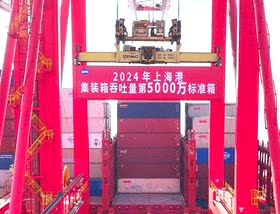
Yesterday morning in the terminal of the fourth phase of construction
Shanghai Port New Yangshan Port Area A Crane
fully automated embarked on a container ship the
container with which the Chinese port reached for the first time
the number of 50 million 20' containers handled
overall in one year, setting a new world record. In
On the occasion of the celebration of this milestone, the President
of Shanghai International Port (Group) Co. (SIPG), Gu Jinshan, has
highlighted that Shanghai will rank first this year
world port for the fifteenth consecutive year.
 Container traffic in the port of Shanghai is
started on September 26, 1978 when the container carrier Ping
Xiang Cheng of the COSCO company sailed from the port
to Sydney, inaugurating the first maritime service
China International Containerized Containerized. That year the traffic
total of containers in Shanghai was equal to only 7,951 TEUs. In the
1994 the Chinese port exceeded the threshold of
a million TEUs handled in one year and the following year entered
in the top twenty of the world's container ports. In 2003 the airport
exceeded ten million TEUs and then rose in
2006, 2011 and 2017 respectively at annual traffic volumes of
to 20 million, 30 million and 40 million TEUs.
Container traffic in the port of Shanghai is
started on September 26, 1978 when the container carrier Ping
Xiang Cheng of the COSCO company sailed from the port
to Sydney, inaugurating the first maritime service
China International Containerized Containerized. That year the traffic
total of containers in Shanghai was equal to only 7,951 TEUs. In the
1994 the Chinese port exceeded the threshold of
a million TEUs handled in one year and the following year entered
in the top twenty of the world's container ports. In 2003 the airport
exceeded ten million TEUs and then rose in
2006, 2011 and 2017 respectively at annual traffic volumes of
to 20 million, 30 million and 40 million TEUs.
Currently, almost 350 services call at the port of Shanghai
international seafarers connecting it to more than 700 ports
from over 200 countries. SIPG highlighted that Shanghai is at the
First place in the ranking of the best connectivity
world port for 13 years now consecutively and the only
Yangshan Port has been at the top of the Container for two years
Port Performance Index of the World Bank. In the last seven years
the fourth phase of Yangshan Port, which was started in
2017, repeatedly set traffic records by reaching
handle a total of more than 35 million TEUs, with the
2024 which will end with a new record of over seven
million TEUs. SIPG has specified that in this port area the
number of port workers is 70% lower than in
traditional non-automated container terminals, while
The overall efficiency of the China terminal has increased by
30% and the per capita work efficiency is higher
by 213% compared to traditional terminals.